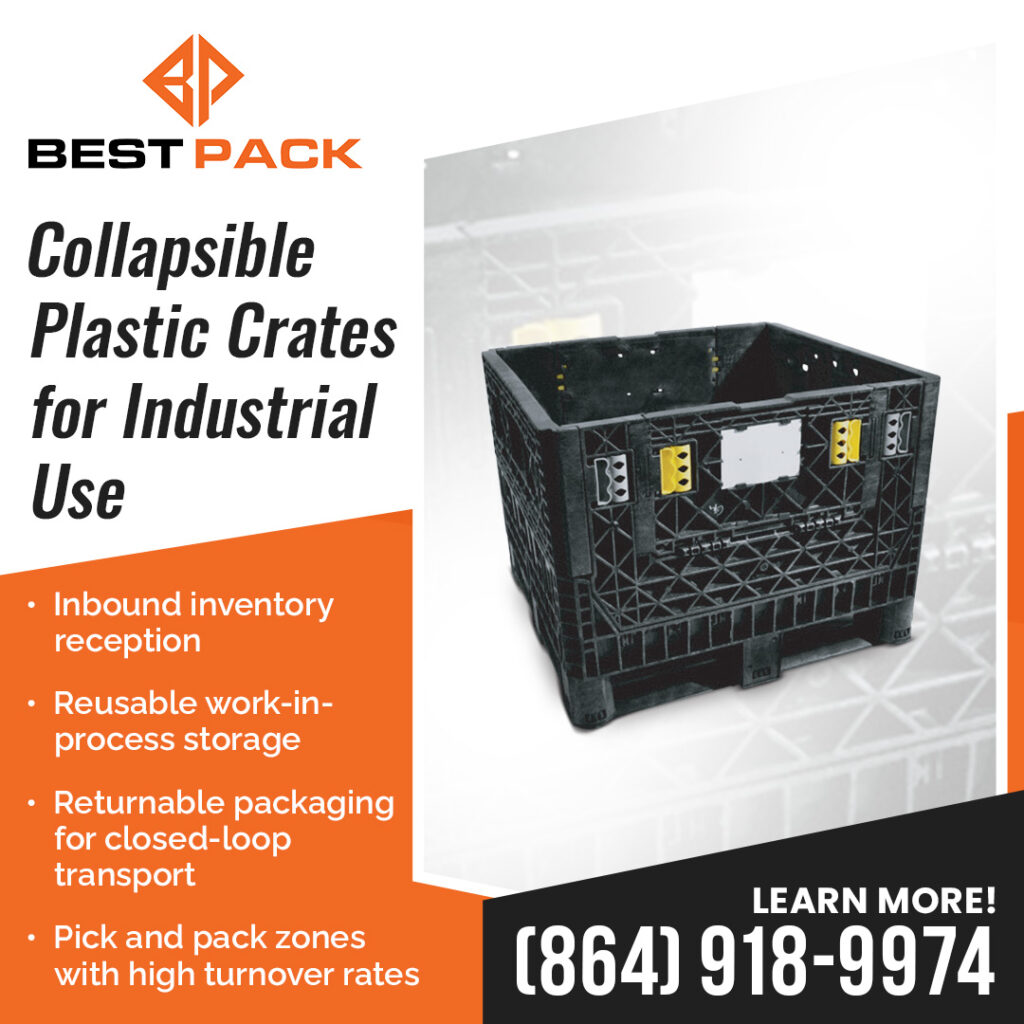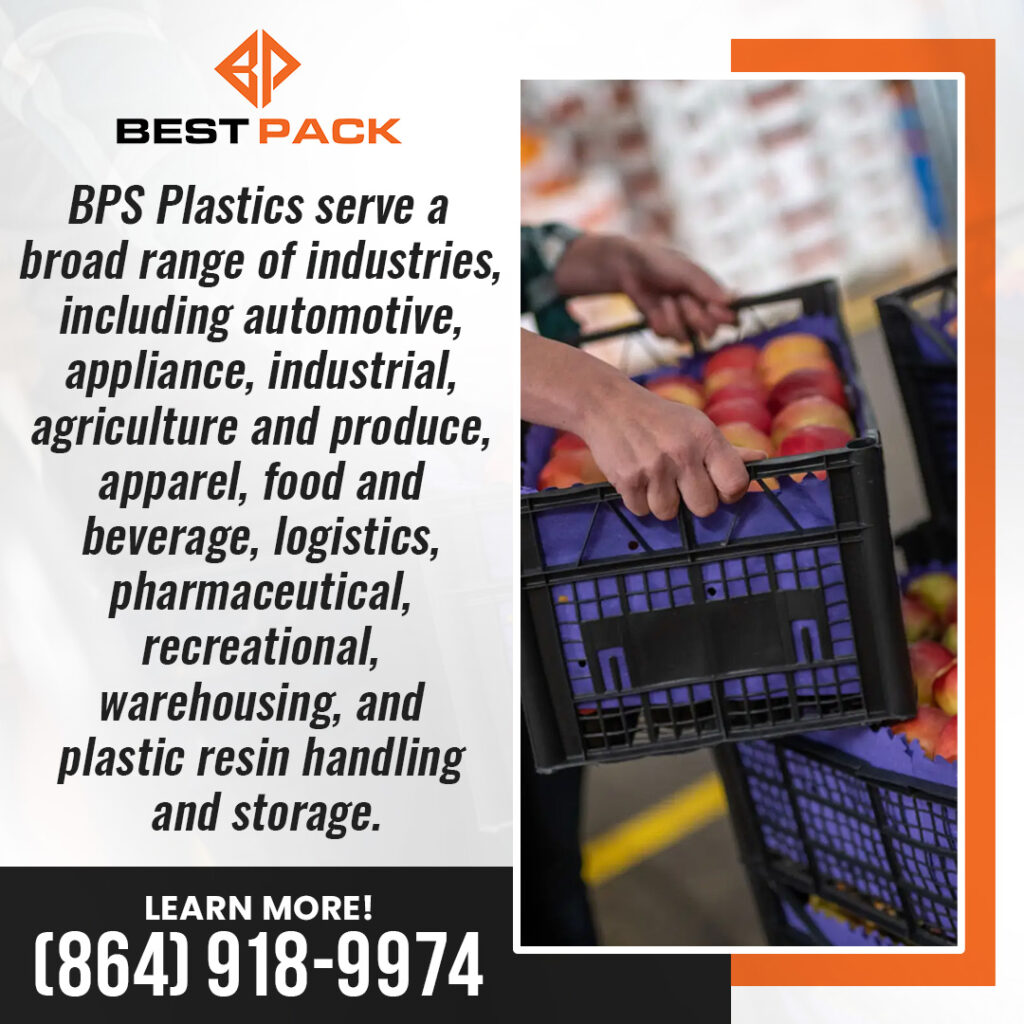At BPS Plastics in Fountain Inn, SC, we work with warehouse operators who face a constant challenge—managing limited space while moving goods quickly and efficiently. As storage costs rise and customer demand increases, every square foot of a warehouse must be used with precision. Our collapsible containers offer a practical solution that helps warehouses improve storage density, reduce return freight volume, and move goods faster without compromising safety or quality.
In this article, we explore how collapsible containers, like collapsible plastic storage crates, streamline warehouse operations and improve throughput.
Key Takeaways
- Collapsible containers reduce warehouse storage volume.
- Return logistics become more efficient with collapsible containers.
- Collapsible containers accelerate order picking and inventory flow.
- Using collapsible containers supports modular and scalable operations.
- Collapsible containers promote sustainability and long-term reuse.

The Core Problem: Space and Speed Constraints
Warehouses operate under two persistent limitations: space and time.
- Space
The research examined by CCR‑Mag shows that once a warehouse reaches about 85% of its pallet rack capacity, efficiency often drops due to reduced aisle width, visibility issues, and slower picking, highlighting the importance of keeping occupancy below this threshold.
- Time
The pressure to fulfill orders quickly has led to more demand for just-in-time storage and fast-pick operations.
Traditional storage solutions like rigid totes or wooden pallets take up unnecessary room, especially when empty. They often lead to aisle congestion, stacked overflow in high racks, or expanded storage leases, all of which add cost and reduce efficiency.
Traditional Containers and Their Disadvantages
Traditional storage containers, such as rigid plastic bins, wooden crates, and cardboard boxes, have been used in warehouses for decades. While these options offer basic structural support for storing and transporting goods, they come with several limitations that affect modern warehouse performance.
Rigid plastic and wooden containers occupy the same volume, whether full or empty, creating storage inefficiencies. When not in use, they take up valuable warehouse space, contributing to clutter and congestion in aisles, staging zones, and racking systems. This reduces flexibility and makes it harder to adapt to layout changes or seasonal inventory shifts.
Cardboard boxes, though lightweight and disposable, are prone to damage from moisture, stacking, and repeated handling. They degrade quickly in high-turnover environments and often require replacement after just one use, increasing costs and waste. Additionally, none of these traditional options support efficient return logistics, as they are either too bulky or not durable enough for closed-loop reuse.
In fast-paced warehouses focused on reducing costs, optimizing space, and improving handling speed, traditional containers often create more limitations than value. As supply chain demands grow, many facilities are shifting toward collapsible containers or collapsible crates to improve flexibility, reduce waste, and streamline operations.
How Collapsible Containers Solve the Problem
Our line of collapsible crates addresses these challenges directly. When full, they provide the structure and protection needed for safe transport. When empty, they fold flat, allowing more units to be stored in less space.
This dual function solves two key warehouse problems:
- Return logistics inefficiency
When products are shipped out, the containers often return empty. Rigid containers take up just as much space on the return trip as they do when full, leading to higher transportation costs and inefficient use of freight space. Collapsible containers fold flat, allowing more units to fit on each return trip, which reduces backhaul volume, fuel use, and freight expenses.
- Empty container storage overflow
Warehouses need space to store empty containers between uses. Traditional rigid containers consume the same amount of space, whether they’re full or empty, creating congestion in storage areas. Collapsible containers, however, are reduced to a fraction of their full size, freeing up valuable floor space for active inventory, staging, or workflow improvements.
By addressing both transportation and storage challenges, collapsible containers improve operational flow and reduce unnecessary space consumption.
Folded Dimensions Matter
A plastic collapsible crate can collapse to a fraction of its full volume. In many cases, one folded crate occupies only 20–30% of its expanded size. This allows us to fit up to three times as many empty crates into the same space compared to rigid units.
Real-World Space Savings
Let’s break it down with an example:
- A traditional rigid milk crate holds about 1.5 cubic feet when empty, while its collapsible version folds down to just 2.7 inches in height, reducing storage space substantially.
Stack 100 of these, and you’re saving over 100 cubic feet of warehouse space—enough to free up a full pallet location.
Across hundreds or thousands of units, the efficiency becomes measurable. This space can then be used for active inventory or staging, improving warehouse layout and flow. Space reallocation leads to faster putaway times, better slotting, and fewer aisle obstructions.
Benefits During Transport and Returns
Warehouses aren’t just storage hubs; they’re transit points. Every day, containers arrive and depart, many of them returning empty. That’s where collapsible crates provide another advantage.
- Return freight volume drops when empty crates fold flat.
- Fewer return trips are needed to bring back empty containers.
- Logistics partners benefit from reduced fuel consumption and lower backhaul rates.
Return freight loads can be reduced after switching to collapsible containers. With fewer trucks returning empty containers, you can save on fuel, labor, and unloading time. There will also be a drop in damaged returns because the containers were less bulky and easier to secure during transport.
Faster Picking, Sorting, and Storage
Plastic collapsible crates aren’t just compact—they’re also easy to handle. Designed with ergonomic grips, interlocking corners, and light but strong construction, they move easily along conveyors or warehouse pick lines.
In high-turnover zones, areas where products move quickly and frequently, collapsible containers improve workflow speed and accuracy. They support the following tasks:
- Order picking: Workers can access items more quickly because collapsible containers are lightweight, easy to handle, and stack efficiently. This reduces the time it takes to locate and move products during order fulfillment.
- Bin replenishment: When inventory runs low, new stock needs to be added to the picking bins. Collapsible containers streamline this process because they’re easy to move, open, and restock without creating clutter.
- Returns processing: Returned items often need to be sorted, inspected, and restaged. Collapsible containers provide a clean, organized way to handle and transport these items through the returns workflow.
- Inventory checks: During cycle counts or audits, collapsible crates help workers move and count items more easily. Their uniform size and clear visibility reduce confusion and miscounts.
- Seasonal resets: When warehouse layouts change to accommodate seasonal demand (like holiday stock), collapsible containers support fast transitions. They can be folded, relocated, and redeployed without requiring extra shelf space.
These benefits make collapsible containers ideal for fast-moving warehouse environments where efficiency and adaptability are essential.
We’ve seen customers reduce their pick-to-pack cycle times by using our collapsible plastic crates with color-coded lids and integrated label slots. These small details help reduce mispicks and improve productivity. When workers can grab, scan, and move containers quickly, order accuracy and fulfillment rates rise.
Storage Flexibility
Not all warehouses have racking systems with uniform shelf dimensions. That’s why we manufacture collapsible plastic storage crates in a variety of footprints.
Stackability matters, too. Our crates lock into place when stacked upright and remain stable during high-density storage. Forklift-compatible bases make it easy to move entire stacks without restacking.
When folded, they nest securely to prevent shifting or damage—an important feature for both warehouse safety and transportation. Their uniform dimensions also make them easier to count, audit, and reconcile during shift changes or stock checks.
Modular and Scalable Use
One of the reasons warehouses adopt collapsible containers is the ability to scale storage and transport solutions without reconfiguring the entire layout.
Some use case examples include:
- Overflow management during peak seasons
During busy periods like holidays or harvests, warehouses receive more inventory than usual. Collapsible containers help manage overflow by providing extra storage that can be folded and stored when demand drops.
- Closed-loop systems between regional warehouses
In a closed-loop system, containers are shipped from one warehouse to another and returned for reuse. Collapsible containers are ideal because they take up less space on return trips, lowering backhaul costs.
- Temporary staging for value-added services like kitting or repackaging
Some warehouses perform services like assembling product kits or repackaging items. Collapsible containers provide temporary, mobile storage for these operations and can be folded away when not in use.
- Swap programs for inbound and outbound carriers
Logistics partners may exchange empty containers when delivering full ones. Collapsible crates simplify this swap process by reducing the volume of empties carriers must return.
- Load consolidation for multi-stop distribution routes
For trucks making multiple deliveries and pick-ups, collapsible containers help combine partial loads efficiently. This maximizes trailer space and reduces the number of trips needed.
Instead of investing in permanent racking or expansion, collapsible crates offer a mobile, modular solution that supports fast changes in workflow. They enable quick adaptations to seasonal demand, facility expansions, or process redesigns.
Long-Term Durability and Reuse
Plastic collapsible crates are built for repeat use. Unlike cardboard boxes or wooden bins, they resist moisture, impacts, and temperature shifts. This matters in warehouses that process refrigerated goods, sensitive electronics, or heavy equipment parts.
On average, our collapsible containers complete hundreds of cycles before replacement. Some of our long-term customers have used the same units for over five years with minimal wear. This durability reduces reorder frequency and supports waste reduction goals. When crates reach the end of their service life, we offer recycling programs to repurpose the material for new production.
How Our Clients Use Collapsible Containers
Food & Beverage Warehouses
In facilities storing packaged foods or beverages, our plastic collapsible crates help reduce cross-contamination risk. Their washable surfaces make them ideal for operations that demand hygiene compliance. Containers are often color-coded by ingredient type to reduce allergen cross-contact.
Automotive Parts Distribution
In the automotive sector, collapsible plastic storage crates hold everything from small parts to heavy components. When production shifts or part numbers change, the crates can be folded and returned to the origin point without taking up space on warehouse racks.
eCommerce Fulfillment
For online retailers, the pressure is always on to pick, pack, and ship faster. Our collapsible crates support return logistics and reduce the need for cardboard boxes during internal transfers. They also streamline returns inspections by consolidating damaged or unsold items for quality checks.
Environmental and Regulatory Benefits
Many warehouses now include sustainability metrics in their KPIs. Collapsible containers contribute by:
- Less Packaging Waste:
Collapsible containers are reusable, which means fewer single-use boxes, wraps, or pallets are thrown away after each shipment.
- Lower Transport Emissions:
Because empty containers fold flat, more can fit on a return trip. This reduces the number of trucks needed and cuts fuel use and carbon emissions.
- Reduced Use of Disposable Materials:
Unlike cardboard or shrink wrap, collapsible containers don’t need to be replaced after every use. This cuts down on the demand for disposable packaging.
- Participation in Closed-Loop Recycling:
When collapsible containers reach the end of their usable life, many can be recycled into new products. This keeps plastic out of landfills and supports the circular use of materials.
Because our containers are made from recyclable materials, they also fit into circular logistics programs. This helps warehouses align with environmental standards and client sustainability goals.
Industry Trends Point to Growth
The adoption of reusable, collapsible containers is rising across the logistics and warehouse sectors.
- As per Future Market Insights, the collapsible rigid container market is projected to grow by 4.9% CAGR through 2033.
- As per market research, warehouses report up to 30% cost savings when switching from rigid to collapsible containers.
- A 2023 survey reported in Supply Chain Management Review found that 44% of distribution center operators cited a lack of space as their top challenge, making it the most common issue that year.
These numbers reflect what we see from our clients daily. As space and speed remain top priorities, more facilities are investing in tools that solve both problems at once.

Why We Focus on Collapsible Crates
At BPS Plastics, we don’t treat containers as simple storage products. We view them as workflow tools that support higher efficiency in complex warehouse environments. Each plastic collapsible crate we manufacture is tested for:
- Load-bearing strength
- Stack compatibility
- Locking and folding mechanisms
- Resistance to repeated use
We work directly with warehouse managers to match crate specifications to floor layouts, conveyor systems, and shipping volumes. We adjust form factors, handle designs, and lid features to meet operational needs.
Frequently Asked Questions
- Do collapsible containers come in different sizes?
Yes. Collapsible containers are available in various footprints, heights, and capacities. Common sizes are designed to fit standard pallets, shelving systems, and modular warehouse layouts.
- How long do collapsible containers last?
Collapsible containers are built for durability and long-term use. With proper care and handling, many users report reliable performance for several years, even with frequent use and minimal maintenance.
- Are lids available for collapsible containers?
Yes. Many models include optional or integrated lids to protect contents during storage and transport. Contact our team at BPS Plastics in Fountain Inn, SC, for more information.
- How do collapsible containers improve workplace safety?
By reducing clutter from empty rigid bins, collapsible containers lower trip hazards and free up aisle space. Their ergonomic handles and secure stacking also reduce strain and handling errors.
- Can collapsible containers be cleaned and sanitized?
Yes. Most are designed with smooth, washable surfaces and drain holes. This makes them suitable for hygienic environments such as food processing, pharmaceuticals, and healthcare logistics.
Final Thoughts
The demands placed on modern warehouses are only growing. Space is more expensive, labor is harder to secure, and customers expect faster delivery. By switching to collapsible containers, warehouses can make measurable gains in efficiency without expanding their footprint or overhauling operations.
Whether it’s a collapsible plastic storage crate for secure racking or a collapsible plastic crate for fast picking and returns, our products help warehouses do more with less.
Ready to improve your warehouse operations with collapsible crates? Contact the BPS Plastics team at info@bpspackaging.com or call (864) 918-9974 for product specs, pricing, and personalized support.
